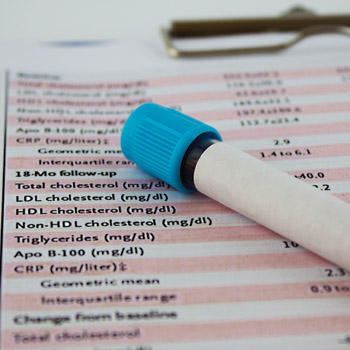Why internists should care about lipoprotein(a)
Lipoprotein(a) can be a significant risk factor for heart disease and requires consideration when developing a plan of care, especially in the highest risk patients.
Internists are used to keeping a close eye on patients' cholesterol, but most do not routinely test for lipoprotein(a), a lesser known but still significant risk factor for heart disease. However, according to a recent scientific statement by the National Lipid Association, an estimated 20% of the U.S. population has dangerously high levels of Lp(a), putting them at earlier risk for heart attacks and strokes.
“Lp(a) has been shown to be an independent risk factor for cardiovascular disease that plays a causal role in atherosclerotic plaques and may be prothrombotic,” said Antonio M. Gotto Jr., MD, DPhil, MACP, medical provost and medical dean emeritus at Weill Cornell Medical College in New York City and president of the National Lipid Association. “It is particularly important to measure in people who are at high risk for cardiovascular disease.”

Despite being a proven risk factor for heart attack and stroke, Lp(a) has not received the same level of attention as LDL cholesterol and other cardiovascular risk factors. Many physicians either aren't aware of it or do not see the value in testing, since Lp(a) is not responsive to statin therapy and there are no other approved treatments, experts said.
But elevated Lp(a) levels raise a person's overall cardiovascular risk profile, which can inform clinical management strategies. For example, a physician might consider more aggressive statin therapy to lower LDL cholesterol levels in patients who also have high levels of Lp(a), as a way of lowering overall risk, according to ACP Member Adam Berman, MD, a cardiovascular medicine research fellow at Brigham and Women's Hospital in Boston.
“Knowing that someone has this risk marker is very helpful because you can stress the importance of lifestyle modifications and perhaps suggest starting a statin,” he said. “These patients will also hopefully be candidates for promising new therapies that are in development and may be available in the near future.”
When to test
The level of Lp(a) in the blood is almost entirely genetically determined and tends to stay constant throughout a person's lifetime. For that reason, some experts believe it makes sense for everyone to get tested at least once.
The lab test is inexpensive, typically between $25 to $50, and widely available across the country, noted Henry Ginsberg, MD, Irving Professor of Medicine at Columbia University in New York City and a leading expert on Lp(a).
“The environment has very little to do with Lp(a). Once we measure it, we know what a person's level is and we can try to lower their overall risk and make sure their family members get tested,” he said. “We shouldn't wait for people to have events before we measure, because about a quarter of those people will die.”
High levels of Lp(a) circulating in the bloodstream, defined as above 50 mg/dL, cause gradual narrowing of the arteries, increasing the risk of clots, heart attack, and stroke. However, most people are unaware of their risk because they never get tested, experts said.
Universal testing may be down the road, but for now, the evidence is insufficient to recommend it, said Laurence S. Sperling, MD, FACP, Katz Professor and founder of the Heart Disease Prevention Center at Emory Healthcare in Atlanta, who served on the writing committee for the most recent cholesterol management guideline issued by the American College of Cardiology/American Heart Association. The guideline cited elevated Lp(a) levels as a risk-enhancing factor for cardiovascular disease.
“Lp(a) should be considered in addition to traditional risk factors included in the 10-year cardiovascular risk estimator,” he said. “Elevated levels magnify patients' risk above and beyond the traditional risk score.”
Besides personal or family history of premature heart disease, internists should think about Lp(a) testing in patients who have had early-onset aortic stenosis in absence of a bicuspid valve, said Dr. Sperling. Other categories include patients with genetic conditions that magnify cardiovascular risk in combination with an elevated Lp(a) levels, such as familial hypercholesterolemia.
In its recent scientific statement on the use of Lp(a) in clinical practice, published in the June 2019 Journal of Clinical Lipidology, the National Lipid Association recommends ordering Lp(a) testing in adults with a family or personal history of premature cardiovascular disease (defined as <55 years for men and <65 years for women) and those with primary severe hypercholesterolemia (low-density lipoprotein [LDL] cholesterol level ≥190 mg/dL). It also suggests testing in patients with borderline 10-year cardiovascular risk scores, to aid in discussions about whether to prescribe statin therapy.
Ongoing clinical management
Despite the lack of targeted treatments for lowering Lp(a), knowing whether a patient has high or low levels can factor into clinical management decisions, said Dr. Sperling.
“Elevated Lp(a) should be considered in the context of a patient's other risk factors,” he said. “We try to be very aggressive in treating LDL with statins to a lower value than we might otherwise, especially if the patient has known heart disease or subclinical atherosclerosis based on imaging.”
High doses of niacin and hormone replacement therapy (except in women with existing heart disease) are some of the strategies that have been associated with lowering Lp(a) levels. However, they are not recommended due to lack of evidence and possibility of harm in the case of estrogen therapy, according to the National Lipid Association statement.
Another option is LDL apheresis, a process of separating and removing LDL cholesterol from the blood that acutely lowers LDL cholesterol levels and has been shown to lower Lp(a) levels, according to the statement. It is sometimes used in patients with elevated Lp(a) levels and recurrent cardiovascular events but is more common in Europe than in the United States.
Patients with high Lp(a) levels but no other significant risk factors can appear to be very healthy, noted Dr. Berman, who led a review of Lp(a)'s role in cardiovascular disease in the September 2019 Current Opinion in Cardiology. Knowing that they have this added risk factor can trigger a discussion about risk-lowering strategies, he said, including stressing the importance of lifestyle modifications. In addition to lipid-lowering therapy, physicians should also more strongly consider aspirin therapy in patients who have elevated Lp(a) levels.
“Elevated Lp(a) could strengthen the argument for prescribing a statin to a patient with overall borderline cardiovascular risk,” he said. “It can also tip the scales to intervene early in patients with a family history of premature atherosclerotic heart disease.”
New treatments on the horizon
Recent studies have uncovered new information about Lp(a)'s role in heart disease, which is helping to inform development of novel therapies. In one study, published in the March 19, 2019, Circulation, investigators looked at associations between Lp(a) levels and first myocardial infarctions in thousands of patients across seven ethnicities.
The study confirmed an association between having an Lp(a) level of 50 mg/dL or more and experiencing a first myocardial infarction. Although levels were higher among Africans than other ethnic groups, Lp(a) was found to be a risk factor regardless of ethnicity.
A second industry-funded study, published in the same issue, pointed to PCSK9 as a potential therapy. The study found that the PCSK9 inhibitor evolocumab, which is known to effectively lower LDL cholesterol levels, significantly reduced Lp(a) levels when combined with statin therapy in patients with higher baseline levels and established atherosclerotic cardiovascular disease.
Antisense agents, which inhibit production of Lp(a), also show promise as future therapies. Results from a phase 2 industry-funded trial of the antisense agent APO(a)-LRx, published in the Jan. 16 New England Journal of Medicine, reported reductions ranging from 35% to 80% in patients with elevated baseline levels of Lp(a) and established cardiovascular disease.
The potential for new therapies to be approved over the next several years is another reason for internists to start taking Lp(a) seriously, said Dr. Sperling.
“Out of the many things we can measure today, Lp(a) is one of the more important cardiovascular risk-enhancing factors for internists to be aware of,” he said. “The evidence supports measuring it in high-risk subgroups and, if we detect it early, we can raise awareness and be more aggressive about heart disease prevention at a younger age.”




